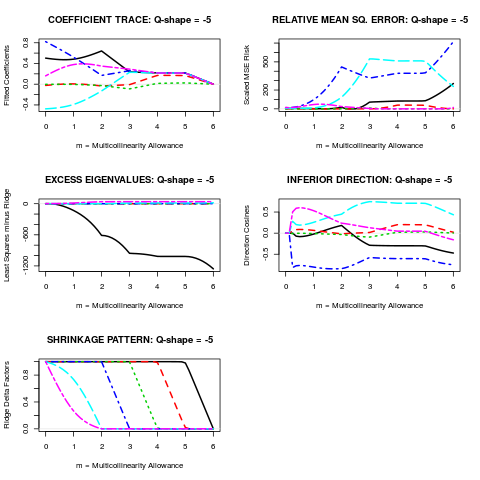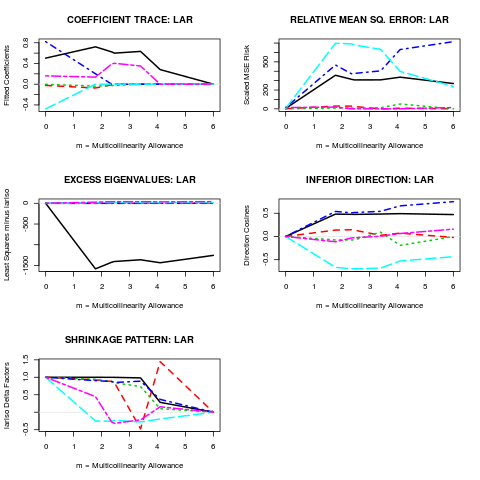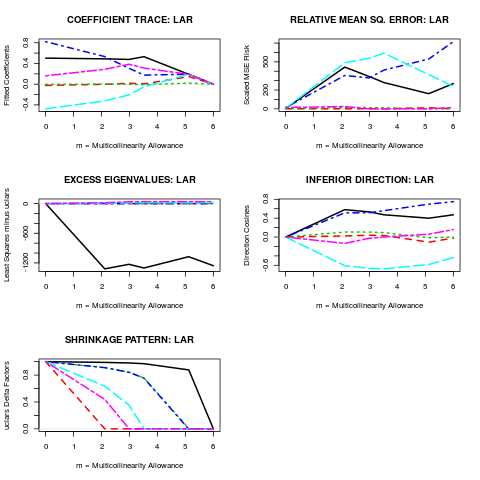Supported by Dr. Osamu Ogasawara and  providing providing  . . |
|
Last data update: 2014.03.03 |
Maximum Likelihood Shrinkage via Generalized Ridge or Least Angle RegressionDescriptionThe functions in this package augment the basic calculations of Generalized Ridge and Least Angle Regression with important visualization tools. Specifically, they display TRACEs of normal-distribution-theory Maximum Likelihood estimates of the key quantities that completely characterize the effects of shrinkage on the MSE Risk of fitted coefficients. Details
RXridge() calculates and displays TRACEs for the Q-shaped shrinkage path, including the M-extent of shrinkage along that path, that are most likely under normal distribution theory to yield optimal reducions in MSE Risk. When regression parameters have specified, KNOWN numerical values, RXtrisk() calculates and displays the corresponding True MSE Risk profiles and RXtsimu() first simulates Y-outcome data then calculates true Squared Error Losss associated with Q-shape shrinkage. RXlarlso() calls the Efron/Hastie lars() R-function to perform Least Angle Regression then augments these calculations with Maximum Likelihood TRACE displays like those of RXridge(). RXuclars() applies Least Angle Regression to the uncorrelated components of a possibly ill-conditioned set of X-variables using a closed-form expression for the lars/lasso shrinkage delta factors that exits in this special case. Author(s)Bob Obenchain <wizbob@att.net> ReferencesEfron B, Hastie T, Johnstone I, Tibshirani R. (2004) Least angle regression. Ann. Statis. 32, 407-499. Goldstein M, Smith AFM. (1974) Ridge-type estimators for regression analysis. J. Roy. Stat. Soc. B 36, 284-291. (2-parameter shrinkage family.) Obenchain RL. (2005) Shrinkage Regression: ridge, BLUP, Bayes, spline and Stein. Electronic book-in-progress (200+ pages.) http://members.iquest.net/~softrx/. Obenchain RL. (2011) shrink.PDF Vignette-like documentation stored in the R library/RXshrink/doc folder. 23 pages. Examplesdemo(longley2) Results
R version 3.3.1 (2016-06-21) -- "Bug in Your Hair"
Copyright (C) 2016 The R Foundation for Statistical Computing
Platform: x86_64-pc-linux-gnu (64-bit)
R is free software and comes with ABSOLUTELY NO WARRANTY.
You are welcome to redistribute it under certain conditions.
Type 'license()' or 'licence()' for distribution details.
R is a collaborative project with many contributors.
Type 'contributors()' for more information and
'citation()' on how to cite R or R packages in publications.
Type 'demo()' for some demos, 'help()' for on-line help, or
'help.start()' for an HTML browser interface to help.
Type 'q()' to quit R.
> library(RXshrink)
Loading required package: lars
Loaded lars 1.2
> png(filename="/home/ddbj/snapshot/RGM3/R_CC/result/RXshrink/RXshrink-package.Rd_%03d_medium.png", width=480, height=480)
> ### Name: RXshrink-package
> ### Title: Maximum Likelihood Shrinkage via Generalized Ridge or Least
> ### Angle Regression
> ### Aliases: RXshrink-package
> ### Keywords: package
>
> ### ** Examples
>
> demo(longley2)
demo(longley2)
---- ~~~~~~~~
> require(RXshrink)
> # input revised Longley dataset of Hoerl(2000).
> data(longley2)
> # Specify form of regression model (linear here)...
> form <- GNP~GNP.deflator+Unemployed+Armed.Forces+Population+Year+Employed
> # Fit of this model using 2-parameter Generalized Ridge Regression
> rxrobj <- RXridge(form, data=longley2)
> rxrobj
RXridge Object: Shrinkage-Ridge Regression Model Specification
Data Frame: longley2
Regression Equation:
GNP ~ GNP.deflator + Unemployed + Armed.Forces + Population +
Year + Employed
Number of Regressor Variables, p = 6
Number of Observations, n = 29
Principal Axis Summary Statistics of Ill-Conditioning...
LAMBDA SV COMP RHO TRAT
1 124.55432117 11.1603907 0.466590166 0.98409260 179.451944
2 34.04395492 5.8347198 -0.009779055 -0.01078296 -1.966301
3 7.97601572 2.8241841 0.228918857 0.12217872 22.279619
4 1.31429584 1.1464274 -0.557948473 -0.12088200 -22.043160
5 0.06505309 0.2550551 0.613987118 0.02959472 5.396677
6 0.04635925 0.2153120 -0.471410409 -0.01918176 -3.497845
Residual Mean Square for Error = 0.0008420418
Estimate of Residual Std. Error = 0.02901796
Classical Maximum Likelihood choice of SHAPE(Q) and EXTENT(M) of
shrinkage in the 2-parameter generalized ridge family...
Q CRLQ M K CHISQ
1 5.0 0.03065132 5.973237 9.992836e+06 212.2772
2 4.5 0.03143266 5.971855 2.123279e+06 212.2758
3 4.0 0.03244203 5.970023 4.476833e+05 212.2739
4 3.5 0.03402277 5.967055 9.194427e+04 212.2709
5 3.0 0.03715373 5.960805 1.752828e+04 212.2644
6 2.5 0.04516043 5.942561 2.721213e+03 212.2453
7 2.0 0.07215281 5.858787 2.496728e+02 212.1532
8 1.5 0.18443773 5.252697 9.850159e+00 211.3015
9 1.0 0.52547213 2.111210 5.428963e-01 202.9410
10 0.5 0.79341430 1.816359 4.358166e-01 183.5424
11 0.0 0.89070908 2.678418 1.513692e+00 166.6511
12 -0.5 0.93599740 3.140371 7.907552e+00 151.8817
13 -1.0 0.95935445 3.453422 5.035840e+01 139.1481
14 -1.5 0.97160704 3.723747 3.725912e+02 129.0260
15 -2.0 0.97800933 3.935491 3.139861e+03 121.8070
16 -2.5 0.98131461 4.068103 2.941270e+04 117.2079
17 -3.0 0.98299124 4.168863 2.970284e+05 114.5558
18 -3.5 0.98382102 4.283839 3.143926e+06 113.1458
19 -4.0 0.98421686 4.427912 3.417785e+07 112.4479
20 -4.5 0.98439456 4.586356 3.768549e+08 112.1289
21 -5.0 0.98446554 4.729924 4.185069e+09 112.0005
Q = -5 is the path shape most likely to lead to minimum
MSE risk because this shape maximizes CRLQ and minimizes CHISQ.
RXridge: Shrinkage PATH Shape = -5
The extent of shrinkage (M value) most likely to be optimal
in the Q-shape = -5 2-parameter ridge family can depend
upon whether one uses the Classical, Empirical Bayes, or Random
Coefficient criterion. In each case, the objective is to
minimize the minus-two-log-likelihood statistics listed below:
M K CLIK EBAY RCOF
0 0.000 0.000000e+00 Inf Inf Inf
1 0.125 1.216886e-09 1.756397e+12 113.2484 113.7283
2 0.250 2.723817e-09 1.759946e+12 112.8258 113.6267
3 0.375 4.619196e-09 1.761921e+12 113.3184 114.2927
4 0.500 7.041824e-09 1.763266e+12 114.2322 115.2383
5 0.625 1.018846e-08 1.764282e+12 115.4263 116.3236
6 0.750 1.433883e-08 1.765097e+12 116.8508 117.4949
7 0.875 1.989252e-08 1.765775e+12 118.4883 118.7274
8 1.000 2.742919e-08 1.766353e+12 120.3319 120.0052
9 1.125 3.782128e-08 1.766854e+12 122.3731 121.3120
10 1.250 5.247015e-08 1.767295e+12 124.5961 122.6278
11 1.375 7.384438e-08 1.767690e+12 126.9746 123.9280
12 1.500 1.068417e-07 1.768051e+12 129.4727 125.1831
13 1.625 1.628770e-07 1.768393e+12 132.0423 126.3550
14 1.750 2.762155e-07 1.701520e+12 134.5264 127.2992
15 1.875 6.182665e-07 1.272220e+12 136.0903 127.1936
16 2.000 6.643946e-04 1.015978e+12 125.4323 114.7166
17 2.125 7.362916e-01 3.287066e+10 166.0541 114.1279
18 2.250 1.717996e+00 3.205070e+10 224.4040 123.2937
19 2.375 3.092344e+00 3.183538e+10 283.5606 129.9525
20 2.500 5.153758e+00 2.280920e+10 342.6568 134.7201
21 2.625 8.589062e+00 1.368552e+10 401.6391 138.2106
22 2.750 1.545756e+01 7.604699e+09 460.4319 140.7063
23 2.875 3.603308e+01 3.262206e+09 518.4773 141.8635
24 3.000 1.151864e+03 1.020496e+08 568.7408 134.7453
25 3.125 3.681964e+04 3.192275e+06 620.4632 127.5772
26 3.250 8.582348e+04 1.369417e+06 680.1102 127.9952
27 3.375 1.544348e+05 7.609366e+05 740.5562 128.9705
28 3.500 2.573141e+05 4.566294e+05 801.2635 130.0100
29 3.625 4.286244e+05 2.740626e+05 862.0149 130.9378
30 3.750 7.703843e+05 1.524187e+05 922.6029 131.6017
31 3.875 1.783600e+06 6.576456e+04 982.5073 131.6508
32 4.000 2.001657e+07 5.802433e+03 1034.0751 128.3256
33 4.125 2.246123e+08 5.233168e+02 1037.2882 123.8210
34 4.250 5.199270e+08 2.503376e+02 1039.1120 122.3877
35 4.375 9.341967e+08 1.669789e+02 1042.2842 121.5122
36 4.500 1.555265e+09 1.313719e+02 1047.3773 120.8768
37 4.625 2.588153e+09 1.157462e+02 1056.0587 120.4012
38 4.750 4.641076e+09 1.121409e+02 1073.4679 120.1243
39 4.875 1.062368e+10 1.206503e+02 1124.3692 120.4956
40 5.000 7.624894e+10 1.585962e+02 1675.8231 129.9001
41 5.125 5.472829e+11 1.878722e+02 5146.2928 160.3667
42 5.250 1.252858e+12 1.954643e+02 9119.6085 176.2351
43 5.375 2.246916e+12 1.994637e+02 13126.9105 186.3760
44 5.500 3.740036e+12 2.022119e+02 17143.1003 193.8197
45 5.625 6.229664e+12 2.043992e+02 21162.8987 199.6993
46 5.750 1.120975e+13 2.063548e+02 25184.5175 204.5580
47 5.875 2.615094e+13 2.083713e+02 29207.1835 208.6979
48 6.000 Inf 2.123044e+02 33230.5079 212.3044
Extent of shrinkage statistics...
TSMSE KONST MCAL
0 37.86637 0.000000e+00 0.000
1 35.63211 1.216886e-09 0.125
2 39.12317 2.723817e-09 0.250
3 47.93770 4.619196e-09 0.375
4 61.61001 7.041824e-09 0.500
5 79.63968 1.018846e-08 0.625
6 101.56149 1.433883e-08 0.750
7 127.06069 1.989252e-08 0.875
8 156.63450 2.742919e-08 1.000
9 190.20102 3.782128e-08 1.125
10 228.25031 5.247015e-08 1.250
11 271.54570 7.384438e-08 1.375
12 321.12648 1.068417e-07 1.500
13 379.33422 1.628770e-07 1.625
14 446.84128 2.762155e-07 1.750
15 524.02860 6.182665e-07 1.875
16 611.40396 6.643946e-04 2.000
17 616.62297 7.362916e-01 2.125
18 634.98390 1.717996e+00 2.250
19 662.37733 3.092344e+00 2.375
20 694.87755 5.153758e+00 2.500
21 741.92078 8.589062e+00 2.625
22 799.43676 1.545756e+01 2.750
23 867.39853 3.603308e+01 2.875
24 942.97404 1.151864e+03 3.000
25 946.23548 3.681964e+04 3.125
26 949.33386 8.582348e+04 3.250
27 955.90253 1.544348e+05 3.375
28 964.03468 2.573141e+05 3.500
29 973.73298 4.286244e+05 3.625
30 984.99979 7.703843e+05 3.750
31 997.81842 1.783600e+06 3.875
32 1010.78728 2.001657e+07 4.000
33 1012.16892 2.246123e+08 4.125
34 1012.23283 5.199270e+08 4.250
35 1012.24831 9.341967e+08 4.375
36 1012.25508 1.555265e+09 4.500
37 1012.26255 2.588153e+09 4.625
38 1012.27763 4.641076e+09 4.750
39 1012.32214 1.062368e+10 4.875
40 1012.83817 7.624894e+10 5.000
41 1018.54240 5.472829e+11 5.125
42 1030.33840 1.252858e+12 5.250
43 1047.92954 2.246916e+12 5.375
44 1071.29714 3.740036e+12 5.500
45 1100.43720 6.229664e+12 5.625
46 1135.37352 1.120975e+13 5.750
47 1181.88392 2.615094e+13 5.875
48 1237.17669 Inf 6.000
> names(rxrobj)
[1] "data" "form" "p" "n" "r2" "s2"
[7] "prinstat" "crlqstat" "qmse" "qp" "coef" "rmse"
[13] "exev" "infd" "spat" "mlik" "sext"
> plot(rxrobj)
> cat("\n Press ENTER for Least Angle Regression demo...")
Press ENTER for Least Angle Regression demo...
> scan()
1:
Read 0 items
numeric(0)
> # Fit of the above model with Least Angle Regression
> rxlobj <- RXlarlso(form, data=longley2)
> rxlobj
RXlarlso Object: LARS Maximum Likelihood Shrinkage
Data Frame: longley2
Regression Equation:
GNP ~ GNP.deflator + Unemployed + Armed.Forces + Population +
Year + Employed
Number of Regressor Variables, p = 6
Number of Observations, n = 29
Principal Axis Summary Statistics of Ill-Conditioning...
LAMBDA SV COMP RHO TRAT
1 124.55432117 11.1603907 0.466590166 0.98409260 179.451944
2 34.04395492 5.8347198 -0.009779055 -0.01078296 -1.966301
3 7.97601572 2.8241841 0.228918857 0.12217872 22.279619
4 1.31429584 1.1464274 -0.557948473 -0.12088200 -22.043160
5 0.06505309 0.2550551 0.613987118 0.02959472 5.396677
6 0.04635925 0.2153120 -0.471410409 -0.01918176 -3.497845
Residual Mean Square for Error = 0.0008420418
Estimate of Residual Std. Error = 0.02901796
The extent of shrinkage (M value) most likely to be optimal
depends upon whether one uses the Classical, Empirical Bayes, or
Random Coefficient criterion. In each case, the objective is to
minimize the minus-two-log-likelihood statistics listed below:
M CLIK EBAY RCOF
0 0.000000 Inf Inf Inf
1 1.781335 8.028865e+01 143.8218 71.61305
2 2.362316 1.031755e+02 232.0318 82.12630
3 2.460471 1.086027e+02 280.2866 86.52931
4 3.395439 1.557455e+02 810.7413 112.66440
5 4.096776 1.009984e+12 23947.7492 231.47905
6 6.000000 2.123044e+02 33230.5079 212.30445
Extent of shrinkage statistics...
TSMSE MCAL
0 37.86637 0.000000
1 1578.48713 1.781335
2 1413.97919 2.362316
3 1396.36404 2.460471
4 1357.07572 3.395439
5 1425.20255 4.096776
6 1237.17669 6.000000
Output from LARS invocation...
Call:
lars(x = crx, y = cry, type = type, trace = trace, normalize = eps)
R-squared: 0.999
Sequence of LAR moves:
Var 1 6 3 2 4 5
Step 1 2 3 4 5 6
> names(rxlobj)
[1] "data" "form" "p" "n" "r2" "s2"
[7] "prinstat" "gmat" "lars" "coef" "rmse" "exev"
[13] "infd" "spat" "mlik" "sext"
> plot(rxlobj)
> cat("\n Press ENTER for Least Angle fit to Uncorrelated Components...")
Press ENTER for Least Angle fit to Uncorrelated Components...
> scan()
1:
Read 0 items
numeric(0)
> # Fit Least Angle Regression to Uncorrelated Components (closed form)...
> rxuobj <- RXuclars(form, data=longley2)
> rxuobj
RXuclars Object: Uncorrelated Component LARS Shrinkage
Data Frame: longley2
Regression Equation:
GNP ~ GNP.deflator + Unemployed + Armed.Forces + Population +
Year + Employed
Number of Regressor Variables, p = 6
Number of Observations, n = 29
Principal Axis Summary Statistics of Ill-Conditioning...
LAMBDA SV COMP RHO TRAT
1 124.55432117 11.1603907 0.466590166 0.98409260 179.451944
2 34.04395492 5.8347198 -0.009779055 -0.01078296 -1.966301
3 7.97601572 2.8241841 0.228918857 0.12217872 22.279619
4 1.31429584 1.1464274 -0.557948473 -0.12088200 -22.043160
5 0.06505309 0.2550551 0.613987118 0.02959472 5.396677
6 0.04635925 0.2153120 -0.471410409 -0.01918176 -3.497845
Residual Mean Square for Error = 0.0008420418
Estimate of Residual Std. Error = 0.02901796
The extent of shrinkage (M value) most likely to be optimal
depends upon whether one uses the Classical, Empirical Bayes, or
Random Coefficient criterion. In each case, the objective is to
minimize the minus-two-log-likelihood statistics listed below:
M CLIK EBAY RCOF
0 0.000000 Inf Inf Inf
1 2.114916 149.4278 472.3079 100.5459
2 2.983319 157.4982 825.7711 113.6821
3 3.517121 164.6308 1259.1945 124.0563
4 5.112223 187.2225 4980.0349 159.4655
5 5.124154 187.5178 5027.7148 159.7195
6 6.000000 212.3044 33230.5079 212.3044
Extent of shrinkage statistics...
TSMSE MCAL
0 37.86637 0.000000
1 1330.28575 2.114916
2 1226.23804 2.983319
3 1296.89147 3.517121
4 1068.18888 5.112223
5 1069.64994 5.124154
6 1237.17669 6.000000
Output from LARS invocation...
Call:
lars(x = sx$u, y = cry, type = type, trace = trace, normalize = eps)
R-squared: 0.999
Sequence of LAR moves:
Var 1 3 4 5 6 2
Step 1 2 3 4 5 6
> plot(rxuobj)
>
>
>
> dev.off()
null device
1
>
|


